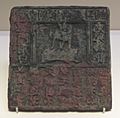Advertising facts for kids
Advertising is how a company encourages people to buy its products, services, or ideas. It's a key part of marketing. Marketing also includes things like design, research, and looking at customer information.
An advertisement, or "ad," is anything that helps people notice these things. Ad agencies usually create ads for a brand or sponsor. Then, they share them with the public using different media. You can see ads on television, radio, in newspapers, magazines, and on billboards in streets and cities. Advertisers use clever ways to get your attention.
Advertisers often try to connect with our emotions. They might use techniques like stereotyping or aiming at a specific audience. This audience is based on things like our jobs, beliefs, personality, self-esteem, lifestyle, friends, and even what we wear.
Contents
How Advertising Started

People have used commercial messages for a very long time. We've found old ads in places like Pompeii and ancient Arabia. In Ancient Greece and Rome, people often advertised "lost and found" items on papyrus. Even today, you can see wall or rock paintings used for advertising in parts of Asia, Africa, and South America. This tradition goes back to Indian rock art from around 4000 BC.
A man named Thomas J. Barratt (1841–1914) from London is often called "the father of modern advertising." He worked for the Pears Soap company. He created famous ad campaigns for their products. These campaigns used catchy slogans, images, and phrases. One of his most famous slogans was, "Good morning. Have you used Pears' soap?" It was well-known even into the 20th century.
Barratt came up with many important ideas for successful advertising. He always said how important it was for Pears to have a strong and unique brand image. He also believed in making sure the product was available everywhere. He knew that tastes change over time. In 1907, he said that advertisers must change with them. An old idea might not work today, he explained.
As the world's economy grew in the 1800s, advertising grew too. In the United States, successful advertising led to more mail-order ads. The rise of mass media was also very important. This included illustrated newspapers in the late 1800s, followed by movies, radio, and television.
Different Kinds of Advertising
Advertising appears in many different forms.
TV and Radio Ads
Many products are advertised on television. Ads usually show up during breaks in a TV show. They are often for products, other TV shows, or movies. They are usually not much longer than 30 seconds. Some radio stations play audio ads between their programmes.
Movie Trailers
An ad for a movie is called a trailer. It shows a short collection of clips from the movie. It also tells you the date the movie will be released in cinemas.
Online Ads
Advertising also happens on websites. These might look like "banner ads" or "popups." They are often still images or animated pictures. The website owner usually gets money when a user clicks on the ad. Sometimes, they get a percentage of the money if someone buys a product.
Outdoor and Vehicle Ads
Billboards advertise products on highways and city streets. These can be large signs on their own or part of street items like bus shelters. Buses and taxis are often covered in ads. Some airlines even allow ads inside their planes. Ads also appear in newspapers, magazines, and sports programmes. Many stadiums have ads placed around them. Sports teams, tournaments, and public events might have a sponsor. This sponsor is often the main advertiser.
How Advertisers Get Your Attention
Advertisers use many different ways to make people notice their ads. They sometimes use images that are meant to be surprising or thought-provoking. Once they get your attention, they need to make the product or brand look good. They might try to make the product seem very appealing. However, advertisers often use humor. This helps people remember the brand, even if the ad doesn't directly promote the product. Bad ads can actually hurt sales or damage a brand's image.
Rules for Advertising
There are growing efforts to protect the public by making rules for advertising. For example, many countries have limits on ads for alcohol, tobacco, or gambling. There are also bans on advertising to children in parts of Europe. Advertising rules often focus on whether the claims are true. Because of this, there are often stricter rules for ads about food and healthcare products.
In some countries, the advertising industry makes its own rules. Advertisers and media companies agree on a set of advertising standards. They try to follow these rules. The main goal of these rules is to make sure all advertising is "legal, decent, honest, and truthful." Some groups that set these rules are funded by the industry but remain independent. An example is the Advertising Standards Authority in the UK.
In the UK, rules control most outdoor advertising, like billboards. Putting up an ad without permission from the Planning Authority is a crime. It can lead to a fine. In the US, many communities feel that outdoor advertising makes public areas look bad. As far back as the 1960s, there were attempts to ban billboards in the countryside. Cities like São Paulo have completely banned them. London also has specific laws to control illegal displays.
Some governments limit the languages that can be used in ads. But advertisers sometimes find ways around these rules. In France, for example, advertisers might print English words in bold. Then, they put the French translation in small print. This is to follow a law from 1994 that limits the use of English.
The advertising of prices is another area governments care about. In the United States, businesses often only mention taxes later in a purchase. In Canada and New Zealand, taxes can be listed separately. But they must be shown upfront. In most other countries, the advertised price must include all taxes. This helps customers easily know the total cost.
Images for kids
-
A modern-day example of advertising: various digital billboards showing varying imagery and text abound Times Square in New York City
-
Bronze plate for printing an advertisement for the Liu family needle shop at Jinan, Song dynasty China. It is the world's earliest identified printed advertising medium.
-
Poster for Pears soap created under Thomas J. Barratt's leadership, 1900. Victoria and Albert Museum, London
-
A Coca-Cola advertisement from the 1890s
-
Advertising for Huntley & Palmers wafers c. 1890
-
An Estonian language advertisement about a cruise between Tallinn and Helsinki in the 1930s
-
A print advertisement for the 1913 issue of the Encyclopædia Britannica
-
Advertisement for a live radio broadcast, sponsored by a milk company, Adohr milk, and published in the Los Angeles Times on May 6, 1930
-
A DBAG Class 101 with UNICEF ads at Ingolstadt main railway station
-
A Transperth bus with an advertisement on its side
-
Hot air balloon displaying advertising for GEO magazine
-
Advertising man pasting a bill for Madame Tussauds, London in 1877
-
The RedEye newspaper advertised to its target market at North Avenue Beach with a sailboat billboard on Lake Michigan.
-
An Allegiant Air aircraft in the special Blue Man Group livery
-
A Zeppelin NT (D-LZFN) of Friedrichshafen used for advertisement
-
Human billboard at the National Multicultural Festival being used to advertise Facebook news feed
See also
 In Spanish: Publicidad para niños
In Spanish: Publicidad para niños



























